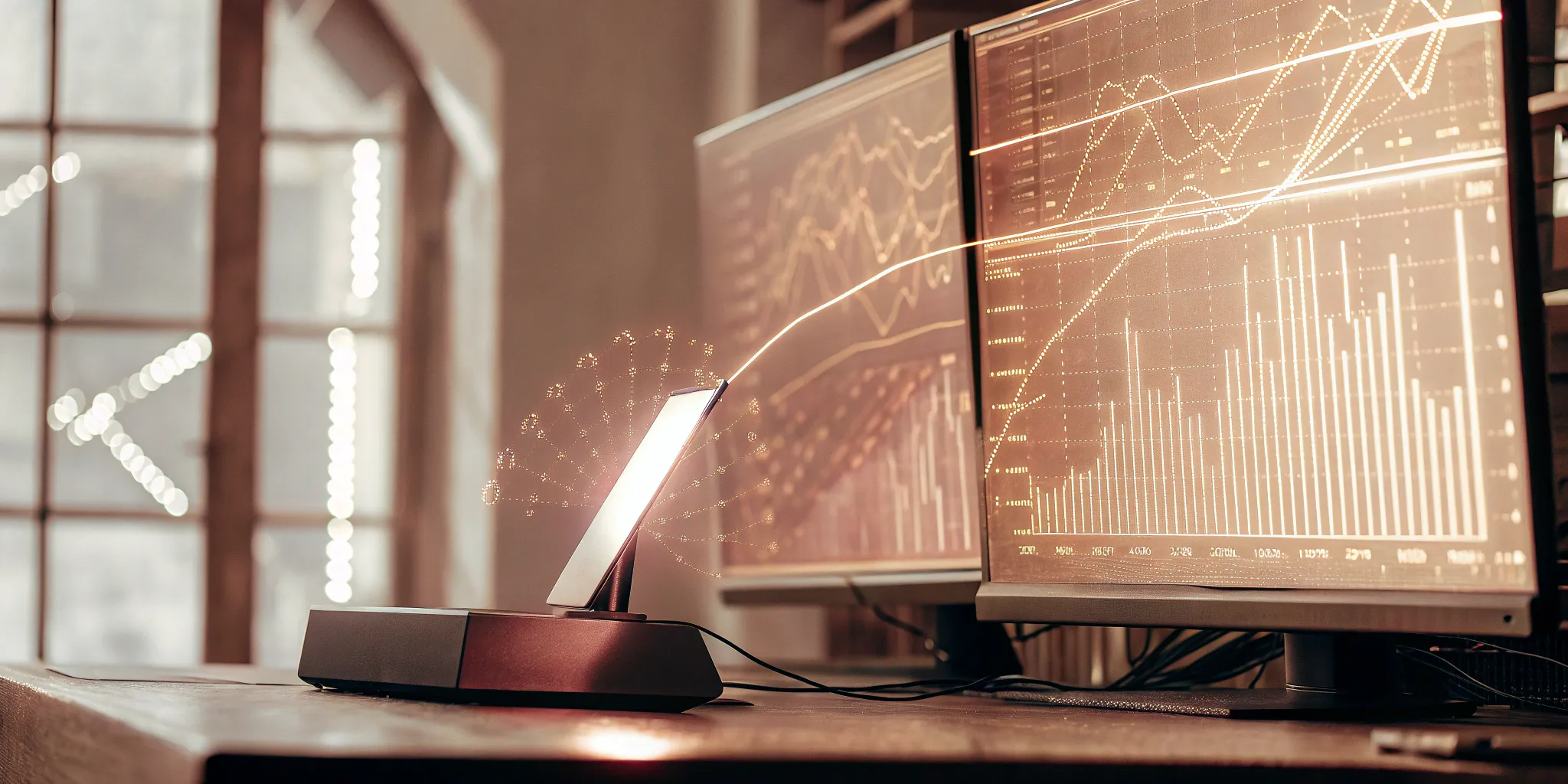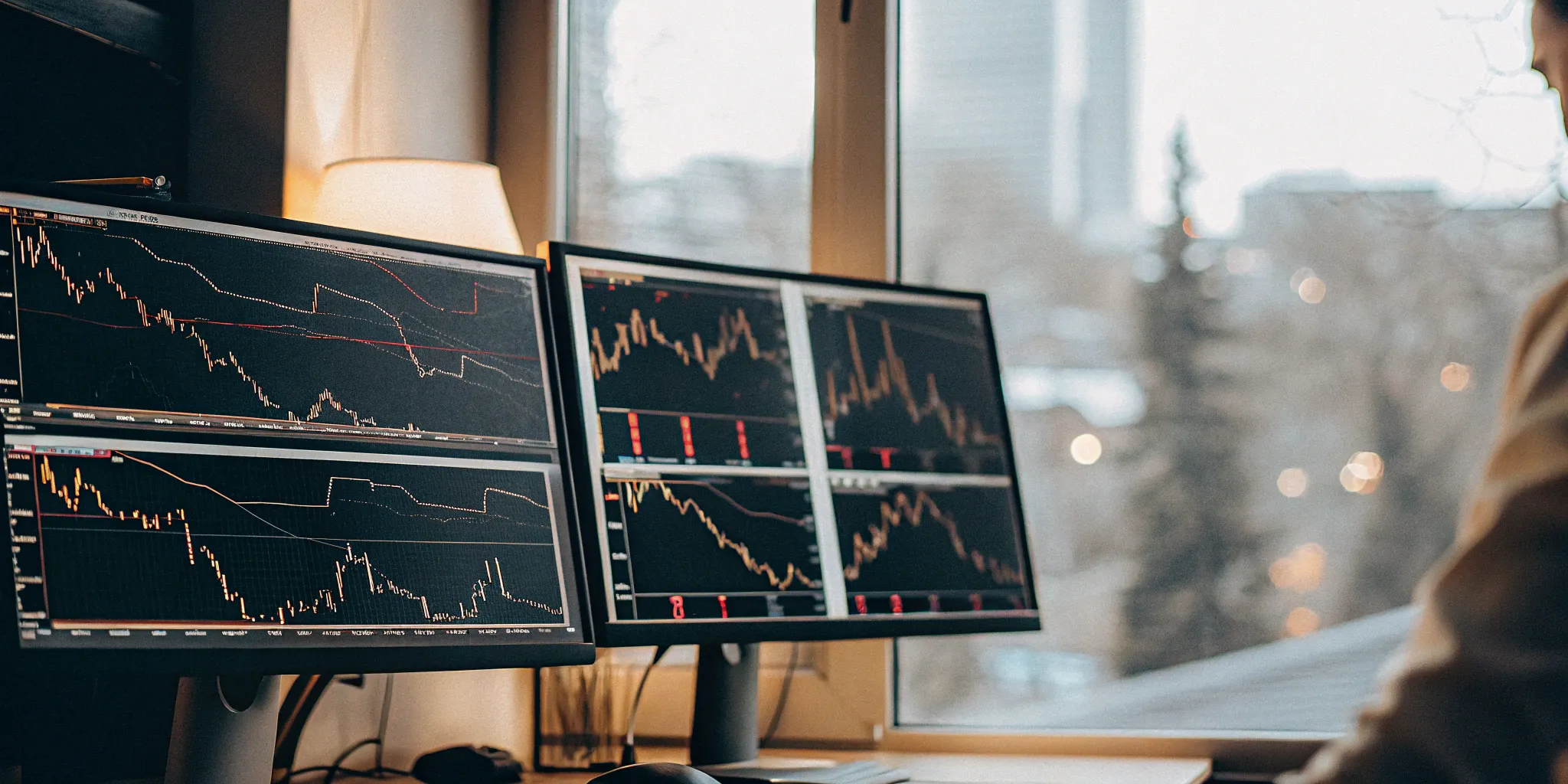Ever wish you could trade like a pro, reacting instantly to market shifts, 24/7? Automatic trading apps make that possible. These sophisticated tools, once exclusive to Wall Street’s elite, are now accessible to everyone. Whether you’re a seasoned trader or just starting, these apps can automate your strategies, removing emotional decision-making and executing trades with lightning-fast precision. This guide explores the world of automatic trading apps, from their core functionality and evolution to choosing the right app and maximizing your success. We’ll cover key features, compare pricing, and address common misconceptions, empowering you to harness the power of automated trading.
Key Takeaways
- Automated trading apps bring speed and efficiency to your strategy: These tools execute trades quickly, eliminating emotional decisions. Remember that markets are inherently risky, and no app guarantees profits.
- Choosing the right app depends on your individual needs: Define your trading goals and preferred markets before exploring platforms. Prioritize a user-friendly interface, robust analytics, and transparent pricing.
- Active management is key, even with automation: Regularly review your automated strategies, stay informed on market events, and adapt your approach as needed. Consistent monitoring and adjustment are crucial for long-term success.
What Are Automatic Trading Apps?
Automatic trading apps, often called “trading bots,” use computer programs to buy and sell assets based on pre-defined rules. Think of it like giving your investment strategy to a robot. You set the parameters—when to buy, when to sell, and how much—and the app executes those trades for you, even while you’re asleep. This automation removes emotional decision-making from trading, which can be especially helpful in fast-moving markets. As IG International explains, automated trading is like having a digital expert manage your investments 24/7, following your instructions precisely. Learn more about automated trading.
Definition and Core Functionality
At their core, these apps execute your trading strategy automatically. You establish the rules, and the software handles the rest. This can involve anything from simple buy and sell orders triggered by specific price points to complex algorithms that analyze market trends and adjust positions accordingly. Many apps offer pre-built strategies or allow you to customize your own using technical indicators, chart patterns, or fundamental analysis. Essentially, they provide a hands-off approach to investing, making it accessible to both seasoned traders and beginners. TruTrade highlights how automated systems have revolutionized real-time strategy execution.
How Automated Trading Has Evolved
Automated trading has come a long way. What was once exclusive to institutional investors is now readily available through user-friendly apps. While the underlying technology—algorithmic trading—has gained popularity, it’s often misunderstood. NURP addresses common myths surrounding algorithmic trading, clarifying its true capabilities and potential benefits. With the right approach, algorithmic trading can be a powerful tool for investors of all levels. Today’s automatic trading apps offer sophisticated features, including backtesting, risk management tools, and real-time market data, empowering individuals to participate in the financial markets with greater efficiency and control. Learn more about dispelling misconceptions about algorithmic trading.
Best Automatic Trading Apps
Choosing the right automatic trading app depends on your individual needs and trading style. Here’s a rundown of some popular options, covering their strengths and target users.
FN Capital’s FAST AI
FN Capital’s FAST AI is designed for investors seeking a fully automated, hands-off approach to forex trading. The platform’s AI-driven algorithm focuses on the EUR/USD pair, prioritizing liquidity and minimizing volatility exposure. With a publicly verified four-year track record and a 100-day money-back guarantee, FAST AI caters to both individuals and institutions looking for consistent, AI-powered returns. Learn more about how FAST AI optimizes forex trading.
Capitalise.ai
Capitalise.ai stands out for its user-friendly approach to automated trading. This platform lets you build trading strategies using plain English, eliminating the need for complex coding. Features like automated execution and real-time notifications make it a solid choice for traders of all levels, from beginners to experienced professionals.
SpeedBot
SpeedBot simplifies algorithmic trading with pre-built templates and customizable parameters. This app caters to both beginners and experienced traders, offering a streamlined way to define, execute, and monitor automated strategies. Explore SpeedBot to see if its features fit your trading style.
MetaTrader 4/5
MetaTrader 4 (MT4) remains a popular choice for forex traders, known for its advanced charting tools and customizable indicators. While it offers robust features for automated trading, MT4 may require a steeper learning curve for beginners. Research automated trading platforms to see if MT4 aligns with your needs.
TradingView
TradingView is a community-driven platform with automatic pattern recognition and broker integration. While its free version offers valuable tools, advanced backtesting capabilities require knowledge of Pine Script. Read reviews of automated trading tools to evaluate TradingView’s suitability for your trading style.
eToro, Robinhood, and TD Ameritrade’s thinkorswim
These platforms offer various automated trading features, often integrated within their broader brokerage services. Research each platform individually to determine if their specific automation tools align with your investment goals and trading strategies.
Essential Features in Automatic Trading Apps
Before diving into specific apps, let’s explore the must-have features for any automatic trading platform. These tools empower you to automate tasks, analyze opportunities, and manage risk effectively.
User-Friendly Interface
A clean, intuitive interface is crucial, especially if you’re new to automated trading. Look for platforms that offer straightforward navigation, clear charts, and easy-to-understand order management tools. A cluttered or complex interface can lead to mistakes and frustration. While Capitalise.ai is known for its user-friendly design, some user reviews mention that more complex strategies can be challenging to implement.
Code-Free Automation
One of the biggest advantages of automatic trading apps is the ability to automate strategies without writing code. Platforms like Capitalise.ai let you create trading strategies using plain English, making automation accessible to everyone, regardless of technical skills. This feature lets you define specific entry and exit rules, set stop-losses, and manage your portfolio automatically.
Advanced Analytics and Backtesting
Robust analytics and backtesting capabilities are essential for evaluating potential strategies. Look for platforms that let you backtest strategies against historical data, simulating trades in a risk-free environment. This helps you understand how your strategy would have performed and make adjustments before risking real capital. Analyzing historical performance is key to refining your approach and maximizing potential returns.
Real-Time Notifications
Staying informed about market movements and trade executions is crucial. Choose a platform that provides real-time notifications via email or mobile alerts. These notifications can alert you to important events, such as when market conditions meet your criteria or when a trade is executed, allowing you to react quickly to market changes and stay on top of your portfolio.
Risk Management Tools
Effective risk management is paramount in trading. A good automatic trading app should offer tools to help you mitigate potential losses. Features like stop-loss orders, position sizing controls, and automated risk assessments are essential. TruTrade emphasizes the importance of sound risk management—including parameters like backtesting, diversification, and performance monitoring—to avoid common trading pitfalls.
Broker Integrations
Seamless integration with your brokerage account is essential for executing trades automatically. Ensure the app you choose is compatible with your preferred broker. SpeedBot, for instance, highlights its compatibility with major brokers, specifically mentioning Tradier for US markets. This integration simplifies trading and ensures efficient order execution.
Customizable Trading Strategies
Flexibility is key in automated trading. Look for platforms that offer customizable trading strategies. Whether you prefer using pre-built algorithms or creating your own, having options is important. SpeedBot offers over 100 pre-built strategies and the ability to customize your own, catering to traders of all experience levels. This allows you to tailor your approach to your specific trading style and market conditions.
Compare Pricing and Subscriptions
Before committing to an automatic trading app, take a close look at the pricing structure. Understanding the costs upfront will help you budget effectively and avoid surprises.
Free vs. Paid Options
Some apps offer basic features for free, while others operate on a freemium model, providing core functionality at no cost and charging for premium features. For example, Capitalise.ai is a free iPhone app that lets users automate their trading strategies without needing a brokerage account. Free access often includes backtesting, simulated trading, and basic notifications. However, more sophisticated features, like advanced charting, real-time data, or complex algorithms, might require a paid subscription.
Subscription Models
Many automatic trading apps use subscription models, typically charging a monthly or annual fee. These subscriptions can range from a few dollars a month to hundreds, depending on the features included. Some platforms offer tiered subscriptions, with higher tiers unlocking more advanced tools and capabilities. When researching different platforms, pay close attention to what each subscription level offers to ensure it aligns with your needs and budget. It’s also worth noting that some brokers may influence which platforms are featured on comparison sites, so do your own research and consider multiple sources before making a decision.
Commission Structures
In addition to subscription fees, be mindful of potential commission structures. Some platforms may charge commissions per trade, while others might incorporate the cost into the spread. You’ll often find a choice between commission-free accounts with higher spreads or commission-based accounts with tighter spreads. Understanding these differences is crucial for calculating your true trading costs. For active traders making frequent trades, a commission-based account with lower spreads might be more cost-effective. Conversely, less active traders might prefer a commission-free model.
Hidden Fees
Finally, watch out for hidden fees. These can include data fees, inactivity fees, withdrawal fees, or other charges not immediately apparent. Carefully review the terms and conditions of any platform you’re considering to uncover any potential hidden costs. Remember that trading always involves risk, and unexpected fees can significantly impact your overall returns. FXEmpire also emphasizes the importance of understanding the risks associated with CFD and forex trading, reminding users to be vigilant about potential hidden fees.
Benefits and Drawbacks of Automatic Trading Apps
Automatic trading apps, often called “trading bots,” offer a range of potential benefits, but it’s crucial to understand the realities and avoid common pitfalls. Let’s explore the advantages, address some misconceptions, and discuss how to balance automation with human oversight.
Advantages of Automatic Trading Apps
Automated trading systems bring speed and efficiency to the forefront. As TruTrade points out, these tools have “revolutionized how traders execute strategies,” enabling faster, more efficient decision-making. Imagine having a tireless assistant executing your plan precisely, 24/7. That’s the core promise of automated trading. These apps can react to market changes instantly, eliminating the delays inherent in manual trading. They also remove emotional responses, helping you stick to your predefined trading strategy. This is particularly helpful in fast-moving markets where split-second decisions can make all the difference.
Common Misconceptions and Risks
One of the biggest misconceptions surrounding automated trading is the idea of guaranteed profits. Let’s be clear: no trading system, automated or otherwise, can guarantee profits. Markets are inherently risky. While AI algorithms can process vast amounts of data and identify potential opportunities, the market remains uncertain. Lune Trading emphasizes that “market conditions are volatile and unpredictable.” NURP echoes this sentiment, debunking the myth that “trading algorithms guarantee profits.” It’s essential to approach automated trading with realistic expectations. Another common trap, highlighted by Coin Bureau, is the belief that bots are “effortless money-makers.” Trading, even with automation, requires careful planning, monitoring, and ongoing adjustment. Over-reliance on complex algorithms without understanding the underlying market dynamics can lead to significant losses.
Balance Automation with Human Oversight
The key to successful automated trading lies in finding the right balance between automation and human oversight. TruTrade offers practical advice: “By setting proper risk management parameters, backtesting your strategies, diversifying your approach, and monitoring your bot’s performance, you can avoid the pitfalls.” This means actively managing your risk, testing your strategies thoroughly before deploying them, and spreading your investments to mitigate potential losses. Regularly monitoring your bot’s performance is crucial. Markets change, and your automated strategies need to adapt. Finally, remember that not all trading algorithms are created equal. NURP wisely advises that it’s “essential to approach them with realistic expectations.” Do your research, understand the limitations of automated systems, and choose a platform that aligns with your trading goals and risk tolerance.
Choose the Right Automatic Trading App
Finding the perfect automatic trading app takes careful consideration. It’s more than just picking the flashiest platform; it’s about aligning the app’s features with your specific trading style and goals. Here’s what to consider:
Define Your Trading Goals
Before browsing apps, define your trading goals. Are you a day trader seeking quick gains, or a long-term investor focused on steady growth? Do you prefer a hands-off approach or actively managing your trades? Automated trading systems offer faster, more efficient decision-making, but their effectiveness depends on how well they match your objectives. Knowing your goals will guide you toward the right app.
Evaluate the User Interface and Experience
A powerful AI trading bot is useless if you can’t understand how to use it. Look for a clean, intuitive interface that simplifies complex tasks. You should easily set up trades, monitor performance, and adjust settings without getting lost. User-friendliness is key, especially if you’re new to automated trading. Don’t assume complex systems automatically equal better results.
Analyze Historical Performance
Past performance isn’t a guarantee of future success, but it is a valuable indicator. Reputable automatic trading apps, like NURP, often publish verified trading results. Review this data. Look for consistent performance over time, rather than focusing solely on short-term gains. A transparent track record can give you confidence in the app’s algorithms and its potential.
Understand Pricing and Costs
Automatic trading apps have various pricing models. Some offer free versions with limited features, while others require paid subscriptions. Before committing, thoroughly research the app’s pricing structure. Factor in transaction fees, subscription costs, and any other potential expenses. Understanding the costs will help you avoid surprises and choose an affordable app.
Check for Regulatory Compliance
Trading in regulated markets offers more security. Ensure your chosen app complies with relevant regulations. This protects your investments and fosters a safer trading environment. A compliant app demonstrates a commitment to ethical practices and builds trust. Do your research and choose a platform that prioritizes security and adheres to industry standards.
Start with Automatic Trading
Getting started with automatic trading can feel daunting, but by breaking it down into smaller steps, you can confidently build your first automated strategy. Remember, the goal is to create a system that reflects your trading style and risk tolerance while taking advantage of the speed and efficiency of automated execution.

Set Up Your First Automated Strategy
Begin by defining your trading goals. Are you aiming for short-term gains or long-term growth? What markets are you interested in—stocks, forex, or crypto? Your answers will shape your initial strategy. Start simple. A basic strategy focusing on clear entry and exit rules is often more effective than a complex one you don’t fully understand. For example, a straightforward moving average crossover strategy can be a good starting point. Once you have a basic strategy, translate it into a set of rules that an automated trading platform can execute. This often involves defining specific indicators, price levels, and order types.
Backtest and Optimize
Before risking real capital, thoroughly backtest your strategy using historical market data. This helps you understand how your strategy would have performed in the past and identify potential weaknesses. Look for patterns in your backtesting results. Are there specific market conditions where your strategy excels or struggles? Use these insights to refine your rules and optimize your strategy for better performance.
Implement Risk Management Rules
Protecting your capital is paramount in trading. Implement clear risk management rules within your automated system. This includes setting stop-loss orders to limit potential losses on each trade and defining your overall risk tolerance for your portfolio. Consider position sizing. How much of your capital are you willing to risk on any single trade? Automated systems can help you strictly adhere to these rules, removing emotional decision-making.
Monitor and Adjust Your Strategy
Even the best automated strategies require ongoing monitoring and adjustment. Regularly review your system’s performance and make tweaks as needed. Market conditions change, and your strategy should adapt accordingly. Keep an eye on key metrics like win rate, average profit/loss per trade, and maximum drawdown. Real-time trading results can offer valuable insights into how your strategy is performing in live market conditions. Don’t be afraid to make changes if your strategy isn’t performing as expected. Trading is a continuous learning process, and adapting your approach is key to long-term success.
Succeed with Automatic Trading Apps
Automated trading apps can be powerful tools, but success requires more than just setting them up and letting them run. Here’s how to make the most of your automated trading strategy:
Review Your Strategy Regularly
Regularly reviewing your automated trading strategies is crucial for long-term success. Markets change, and a winning approach today might not work tomorrow. Don’t just set and forget. Take time to analyze your bot’s performance, looking at key metrics like win rate, profit/loss, and drawdown. Based on your review, adjust your strategy’s parameters, refine entry and exit rules, or even consider a completely new approach if needed. Consistent monitoring and adjustments are key to staying ahead of the curve. Even with automation, active management is essential.
Stay Informed on Market Events
While automated trading apps can analyze vast amounts of data, staying informed about major market events is still important. Unexpected news, economic shifts, or geopolitical events can significantly impact market behavior. Keep an eye on financial news and consider adjusting your automated strategies accordingly. For example, during periods of high volatility, you might want to tighten your risk management parameters or temporarily pause your bots. AI algorithms can handle a lot, but being aware of the bigger picture helps you make informed decisions about your automated trading.
Learn and Adapt Continuously
The world of automated trading is constantly evolving. New technologies, strategies, and tools emerge regularly. Commit to continuous learning to stay on top of the latest advancements. Explore online resources, join trading communities, and consider educational courses to expand your knowledge. Don’t fall into the trap of thinking your initial setup is perfect. Be open to experimenting with new approaches, refining your existing strategies, and adapting to market changes. The more you learn, the better equipped you’ll be to make informed decisions and optimize your automated trading performance.
Diversify Your Automated Strategies
Just like with traditional investing, diversification is key in automated trading. Don’t put all your eggs in one basket. Explore different trading strategies, asset classes, and even automated trading platforms. This approach helps mitigate risk and can lead to more consistent returns over time. Consider using a combination of trend-following strategies, mean reversion strategies, or even arbitrage opportunities. By spreading your risk across various automated systems, you create a more resilient portfolio that can weather market fluctuations.
The Future of Automatic Trading Apps
The world of automatic trading is constantly evolving, driven by technological advancements and shifting market dynamics. Here’s a glimpse into what the future might hold:
AI and Machine Learning Advancements
Artificial intelligence and machine learning are poised to revolutionize automated trading. These technologies can analyze massive datasets, identify complex patterns, and execute trades with speed and precision far beyond human capability. Imagine algorithms that adapt to changing market conditions in real time, optimizing strategies and minimizing risks dynamically. While the potential is enormous, it’s crucial to remember that AI trading doesn’t guarantee profits. Markets are inherently unpredictable, and no algorithm can perfectly forecast future movements, a point Lune Trading emphasizes. Many new traders assume bots are foolproof money-making machines, a misconception Coin Bureau clarifies. A balanced approach, combining the power of AI with human oversight and diligent risk management, is essential.
Enhanced Customization and Social Trading
The future of automatic trading apps will likely offer greater customization, allowing traders to tailor strategies to their specific goals and risk tolerance. Think drag-and-drop interfaces for building custom indicators or AI-powered assistants that suggest optimal parameters based on your trading history. Social trading features may also become more prominent, enabling traders to share strategies, learn from each other, and even pool resources. Transparency will be key, with platforms like Nurp publishing real-time trading results for verification. This allows investors to see an algorithm’s effectiveness before committing capital.
Regulatory Challenges and Compliance
As automatic trading becomes more sophisticated, regulatory scrutiny will inevitably increase. Expect stricter rules around algorithm development, risk management, and investor protection. Navigating this evolving landscape will require platforms and traders to prioritize compliance and transparency. This also means staying informed about best practices for risk management, such as setting parameters, backtesting, and diversifying your approach, as TruTrade advises. While the regulatory landscape may present challenges, it also offers an opportunity to build greater trust and stability within the automated trading ecosystem.
Frequently Asked Questions
Here are answers to some common questions about automatic trading apps:
Do automatic trading apps guarantee profits?
No. While AI algorithms can analyze vast amounts of data and identify potential trading opportunities, market conditions are volatile and unpredictable. Profits are never guaranteed, even with sophisticated automated systems. Remember that past performance doesn’t guarantee future results. Any investment involves risk, including the potential loss of principal.
Are trading algorithms only for large institutions?
Not at all. The idea that algorithmic trading is exclusively for large institutions is a myth. Plenty of platforms cater to individual investors, even though institutions use these tools. Automatic trading apps have made sophisticated trading strategies available to a much wider audience. Look for user-friendly platforms with clear pricing and educational resources.
Do trading algorithms require supervision?
Yes. While automation handles the execution, it’s crucial to monitor your trading algorithms’ performance. Markets change, and your strategies need to adapt. Regular oversight ensures your algorithms function as intended and helps you identify areas for improvement. Don’t just set it and forget it.
What are common mistakes when using automatic trading systems?
One common mistake is neglecting risk management. Define your risk tolerance and set appropriate parameters, including stop-loss orders and position sizing. Another mistake is blindly trusting backtested results without considering real-world market conditions. Always test and refine your strategies in a live environment with proper risk controls.
Can anyone use automatic trading apps?
Yes, with the right knowledge and approach, algorithmic trading is accessible to all experience levels. Start with a reputable platform that offers educational resources and a demo account. Focus on learning the basics of trading and risk management before trying complex strategies. Consistent learning and adaptation are key to long-term success.
Related Articles
- Tech-Savvy Trader’s Handbook: Tools & Strategies for Market Mastery – FN Capital
- AI Trading Bots: An Investor’s Guide to Automated Trading – FN Capital
- Real-World Algorithmic Trading Examples & Strategies – FN Capital
- Benefits of Automated Trading: A Practical Guide – FN Capital
- How AI Improves Algo Trading: Speed, Accuracy & Profits – FN Capital
Frequently Asked Questions
Do automatic trading apps guarantee profits?
No trading system can guarantee profits. Markets are inherently unpredictable. While automated trading apps can execute strategies quickly and efficiently, they don’t eliminate market risk. A well-defined strategy, thorough backtesting, and ongoing risk management are crucial for success, but profits are never a certainty.
Is automated trading only for experienced traders?
Not at all. Many user-friendly platforms cater to all levels, from beginners to seasoned professionals. Look for apps with intuitive interfaces, educational resources, and clear explanations of trading concepts. Start with simple strategies and gradually increase complexity as you gain experience.
What are the key features to look for in an automatic trading app?
Essential features include a user-friendly interface, customizable trading strategies, robust backtesting capabilities, real-time notifications, and effective risk management tools. Seamless integration with your brokerage account is also crucial for smooth trade execution.
How much do automatic trading apps cost?
Pricing varies widely. Some apps offer free versions with limited features, while others use subscription models or charge per trade. Carefully compare pricing structures, including any hidden fees, to find an app that fits your budget.
What are the risks of using automatic trading apps?
Over-reliance on automation without understanding the underlying market dynamics is a significant risk. Technical glitches, unexpected market events, and poorly designed strategies can lead to losses. Active monitoring, risk management, and continuous learning are essential to mitigate these risks.





